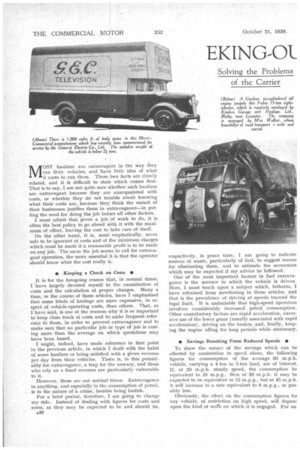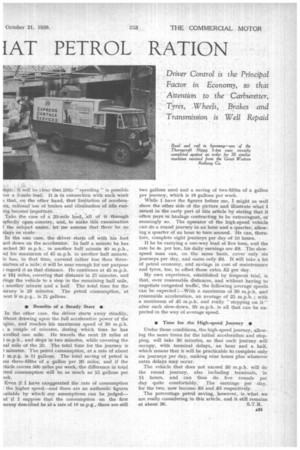EKING-a. [AT PETROL RATION
Page 22

Page 23

If you've noticed an error in this article please click here to report it so we can fix it.
MOST hauliers are. extravagant in the way they run their vehicles, and have little idea of what it costs to run them. These two facts are closely related, and it is difficult to state which comes first. That is to say, I am not quite sure whether such hauliers are extravagant because they are unacquainted with costs, or whether they do not trouble about knowing what their costs are, because they think the nature of their businesses justifies them in extravagance—in putting the need for doing 1he job before all other factors.
I must admit that given a job of work to do, it is often the best policy to go ahead with it with the maximum of effort, leaving the cost to take care of itself.
On the other hand, it is, most emphatically, never safe to be ignorant of costs and of the minimum charges which must be made it a reasonable profit is to be made on any job. The mcre the job seems to call for extravagant operation, the more essential it is that the operator should know what the cost really is.
* Keeping a Check on Costs • It is for the foregoing reason that, in normal times, I have largely devoted myself to the examination of costs and the calculation of proper charges. Many a time, in the course of these articles, have I emphasized that some kinds of haulage are more expensive, in respect of vehicle-operating costs, than others. That, as 1 have said, is one of the reasons why it is so important to keep close track of costs and to make frequent reference to them, in order to prevent extravagance and to make sure that no particular job or type of job is costing more than the average on which quotations may have been based.
I might, indeed, have made reference to that point in the previous article, in which I dealt with the habit of some hauliers of being satisfied with a given revenue per day from their vehicles. There is, in this potentiality for extravagance, a trap for the unwary, and those who rely on a fixed revenue are particularly vulnerable to it.
.However, these are not normal times. Extravagance in anything, and especially in the consumption of petrol, is in the nature of a crime, besides being foolish.
For a brief period, therefore, I am going to change my Ale. Instead of dealing with figures for costs and rates, as they may be expected to be and should be, 4i20 respectively, in peace time, I am going to indicate sources of waste, particularly of fuel, to suggest means for eliminating them, and to estimate the economies which may be expected if my advice be followed.
One of the most important factors in fuel extravagance is the manner in which the vehicle is driven. Here, I must touch upon a subject which, hitherto, I have refrained from mentioning in these articles, and that is the prevalence of driving at speeds beyond the legal limit. It is undeniable that high-speed operation involves considerably increased petrol consumption. Other contributory factors are rapid acceleration, excessive use of the lower gears (usually associated with rapid acceleration), driving on the brakes, and, finally, keeping the engine idling for long periods while stationary.
• Savings Resulting From Reduced Speeds • To show the nature of the savings which can be effected by moderation in speed alone, the following figures for consumption of the average 30 m.p.h. vehicle, carrying a 4 ton to 5-ton load, are of interest. If, at 20 m.p.h. steady speed, the consumption be equivalent to 13 m.p.g., then at 30 m.p.h. it may b€ expected to be equivalent to 12 m.p.g., but at 45 m.p.h. it will increase to a rate equivalent to 9 m.p.g., or possibly less.
Obviously, the effect on the consumption figures foi any vehicle, of restriction on high speed, will depene upon the kind of work on which it is engaged. For ex hipleit will be clear that little " speeding " is possible vet a 5-mile -lead. It is in connection with such work s that, on 'the other hand, that limitation of acceleraon, rational use of brakes and elimination of idle runing become important.. .
Take the case of a 20-mile lead, all of it through erfectly opew country, and, to make this examination f the subject easier, let 'me assume that there be no elays en route.
In the one case, the driver starts off with his foot ard down on the accelerator. In half a minute he has ached 30 m.p.h., in another half minute 40 m.p.h., ad his maximum of 45 m.p.h. in another half minute. le has, in that time, covered rather less than threeuarters of a mile; it will be near enough for out purpose ) regard it as that distance. He continues at 45 m.p.h. w 18/ miles, covering that distance in 25 minutes, and rings the vehicle to a stop in the remaining half mile, another minute and a half. The total time for the
■ urney is 28 minutes The petrol consumption, at pout 9 m.p.g., is 21-, gallons.
• Benefits of a Steady Start • In the other case, the driver starts away steadily, ithout drawing upon the full accelerative power of the igine, and reaches his maximum speed of 30 m.p.h.
a Couple of minutes, during which time he has avelled one mile. He travels the next 18 miles at ) m.p.h., and stops in two minutes, while covering the ial mile of the 20. The total time for the journey is ) minutes. The petrol consumption, at a rate of about ?, m.p.g. is 11 gallons. The total saving of petrol is us three-fifths of a gallon per 20 miles, and if the .hicle covers 500 miles per week, the difference in total .:trol consumption will be as much as 15 gallons per eek.
Even if I have exaggerated the rate of consumption . the higher speed—and there are no authentic figures iailable by which Any assumptions can be judged— idif I suppose that the consumption on the first airrie.y described be at a rate of 10 m.p.g., there are still two gallons used and a saving of two-fifths of a gallon per journey, which is 10 gallons per week.
While I have the figures before me, I might as well show the other side of the picture and illustrate what I meant in the early part of this article by stating that it often pays in haulage contracting to be extravagant, or seemingly so. The operator of the high-speed vehicle can do a round journey in an hour and a quarter, allowing a quarter of an hour to turn around. He can, therefore, complete eight journeys per day of 10 hours.
If he be carrying a one-way load of five tons, and the rate be 4s. per ton, his daily earnings are £8. The slowspeed. man can, on the same basis, cover only six journeys per day, and earns only £6. It will take a lot of petrol economy, and savings in cost of maintenance and tyres, too, to offset those extra £2 per day.
My own experience, established by frequent trial, is that, over reasonable distances, and without having to' negotiate congested traffic, the following average speeds can be expected :—With a maximum of 30 m.p.h. and reasonable acceleration, an average of 25 m..p.h. ; with a maximum of 45 m.p.h. and really "stepping on it" after each slow-down, 33 m.p.h. is all that can be expected in the way of average speed.
• Time for the High-speed Journey •
Under those conditions, the-high-speed journey, allowing the same times for the initial acceleration and stopping, will take 36 minutes, so that each journey will occupy, with terminal delays, an hour and a half, which means that it will be practicable to complete only six journeys per day, making nine hours plus whatever extra delays may occur.
The vehicle that does not exceed 30 m.p.h. will do the round journey, also including terminals, in hours, and can thus do five rounds per day quite comfortably. The earnings per day, for the two, now become £6 and £5 respectively.
The percentage petrol saving, however, is what we are really considering in this article, and it still remains at about 20. S.T.R.




















































